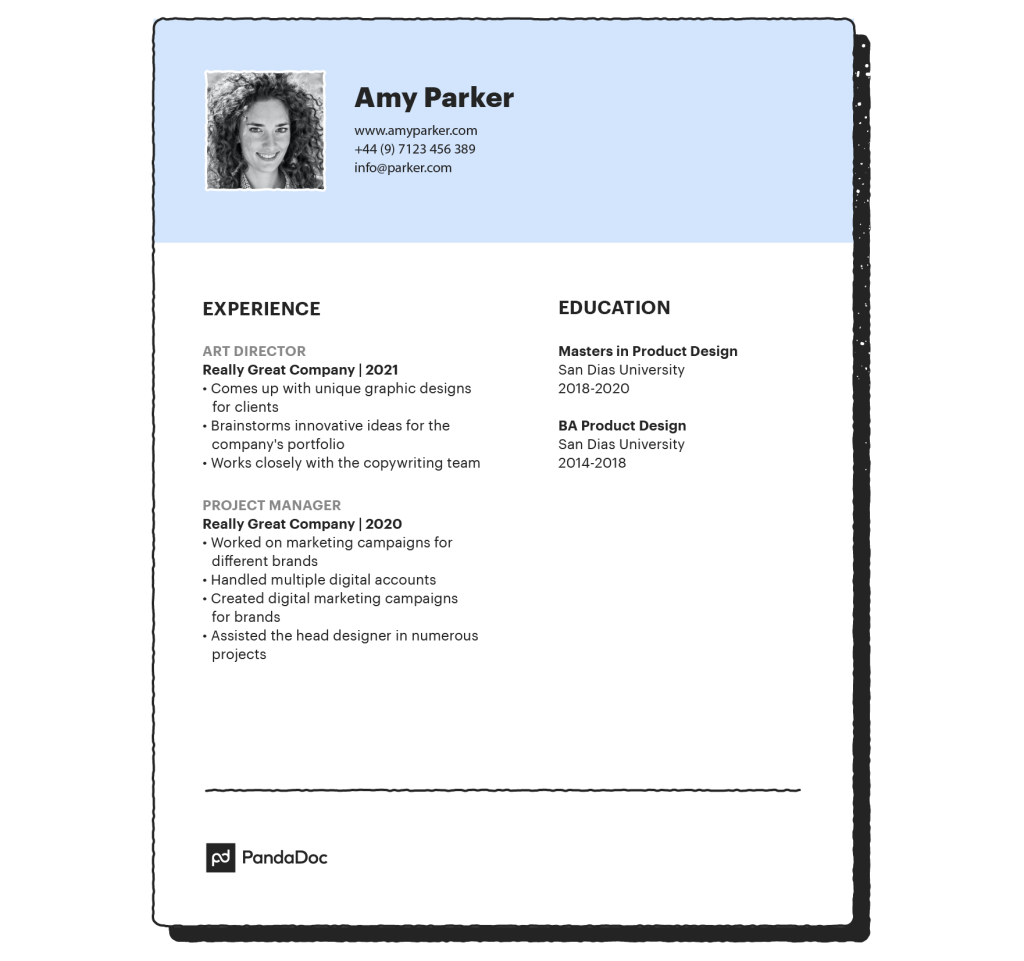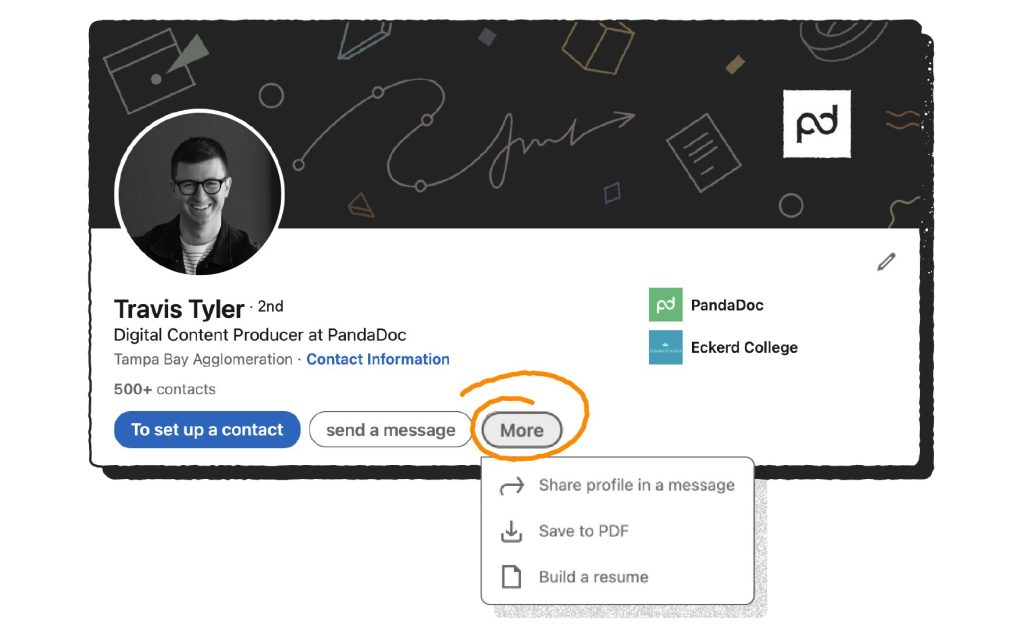Applying for a job is an integral part of the hiring process. Hiring managers always look for job seekers who stand out from the crowd.
But before the interview or any actual interaction with a recruiter, you will have to create and send a resume. A resume can take many forms, but you must choose the one that fits your skillset and your employer’s expectations.
How we source our data
Our PandaDoc team of over 600 professionals is constantly growing. As we search for the best talent worldwide, our recruitment team gets to review dozens of resumes on a daily basis.
We asked our hiring managers about the insights they learned after analyzing thousands of resumes of potential candidates.
What are the dos and don’ts? How to write a resume that gets an interview? Today, we turned these findings into an A-to-Z guide we hope you enjoy.
Even though writing a resume might not seem such a big deal, there are many overlooked mistakes that significantly affect your business opportunities.
Literally, anything, from typos to misuse of headings, will determine your potential employer to skip your resume and keep looking for other candidates.
Third-party guides about different types of resume format
Aside from our own experience, we have also considered some internet articles and guides in our research.
This helped us understand what issues are most commonly overlooked and what we should emphasize to help you build a great resume. Some of the guides and texts we have included in our research are:
- What is the difference between CV and resume?
- Difference Between Cover Letter and Resume (With Table)
- 7 Items To Bring To a Job Interview
- How to Answer Job Interview Questions About Your Resume
CV vs resume vs cover letter
Let’s start with the basics. The first thing we noticed is that people often confuse these three different types of documents used for a job application – CV, resume, and cover letter.
A resume is a short document consisting of a few pages that shows a hiring manager why a particular applicant is qualified for a specific position. We will explore it further below.
A CV is usually a bit longer and more detailed document that goes into details of the candidate’s career, skills and education – you can check out our step-by-step guide on how to write a CV to find out which sections to include.
A cover letter is a complex document that explains why you are the ideal candidate for a particular job. This is more of a storytelling task that lets hiring managers understand your personality and motivation.
To summarize, the main differences between a CV, resume, and a cover letter are:
| Resume | CV | Cover letter | |
|---|---|---|---|
| Length | short | moderate | long |
| Detail | brief | detailed | detailed |
| Format | bullet points | expanded bullet points | story |
| Complexity | simple | complex | complex |
Resume writing 101
Now, when we have identified the main difference of job application docs, let’s dive deeper into writing a resume.
Our hiring managers outlined the five essential steps to maximize your chances of getting a job.
Step 1. Choose a format for your resume
This is the first step you should take to showcase your relevant skills when applying for a job.
Currently, there are three types of formats you can use for your resume:
- reverse-chronological resume
- functional resume
- combination resume or hybrid resume
Each format has its pros and cons. There are cases when it is better to use a specific format. Let’s find out how these formats are different and when you should take advantage of each type.
Reverse-chronological resume
This type of resume is one of the most commonly used formats around the world. It is the perfect choice for people who gradually increase their value year after year.
For example, if you graduated in 2010, worked as an intern for a startup in 2011, switched to a management position in 2012, and so on, this format will work for you.
A reverse-chronological order resume requires candidates to list their work experience and skillset from the current one to the very beginning of their career path.
Therefore, at the top of your resume, you will put the most recent positions while at the bottom you should include the very first companies you have worked for.
The situation is similar when it comes to your skillset. If you have learned how to code in Java in 2021, after graduating in 2018 with a diploma in C#, your resume will list Java first and C# afterwards.
Functional resume
A functional resume is usually your best option if you have just graduated or have no work experience in the field you are applying for.
Therefore, if you are a student applying for an internship at an enterprise-level company, you might want to stick to the functional format.
This type of resume highlights your skills, competencies, education, and knowledge, instead of mentioning your previous work experience.
What is more, if you have been unemployed for a while (due to various reasons), you might want to use the functional resume instead of the reverse-chronological one.
Combined (hybrid) resume
Let’s say you graduated two years ago and want to change your current workplace. You are not a newbie so the functional format isn’t for you.
At the same time, you do not have that much experience so the reverse-chronological form isn’t a choice either. What is your option?
The combined resume (or hybrid resume) is the answer. It works best if you want to showcase both your skills and work experience but you don’t know which of the two before-mentioned formats to use.
The hybrid type includes a highlight of your competencies and skills as well as a reverse-chronological listing of your previous work positions.
Step 2. Sketch your resume
The second step you should perform includes a brief sketch of your resume.
A good resume will usually have six distinct sections, as follows:
- Contact information
- Resume summary
- Skills, abilities and competencies
- Professional experience
- Education
- Awards

Using these six sections, you will touch on all the key points a hiring manager is interested in. The headings of the sections are pretty intuitive.
However, it is essential to carefully read the job posting and determine what you should include in your resume. For example, if you are currently applying for a software engineer position, maybe the fact that you have been part of the knitting club at the university is not your best bet.
Contact information
This section includes all the information a potential employer needs to get in touch with you. Don’t forget to put your full name and address.
Consider adding:
- Phone number
- Email address
- Social Media
- Personal website (if you have one)
Resume summary
The Resume Summary (also known as resume objective) includes a summary statement about yourself. Use it to describe why you are the perfect candidate for this specific job and why the hiring manager should continue reading your resume.
Think of the words and angles that will make you stand out from the crowd. The LinkedIn “About” section is very similar to the Resume Summary if you need to think of an analogy.
Skills, abilities and competencies
The Skills section should include all the relevant information about what you can do as a professional in your field (hard skills) and how you can do it (soft skills).
Soft skills describe you as a person while hard skills are based on job-specific knowledge you received during your previous work experience.
If you are not yet sure about what skill set to include in your resume, here is a list that can help.
Soft skills:
- Dedicated
- Efficient
- Loyal
- Creative
- Active learner
Hard skills:
- C# coding
- SEO marketing
- Foreign language proficiency
- Technical skills
- Proofreading
Professional experience
The Work Experience section should include your employment history. List your previous positions that qualify you for being chosen for this new job.
For the work history section, you might want to use the following format: company name, time period, job title, job description (using action verbs).
Bullet points work great for listing your previous positions as this format is easy to read. Make sure to stick to the facts when putting down the years of your experience.
Volunteer work (or volunteer experience) can be also included in your professional experience section. This is one of the best ways of proving your soft skills instead of highlighting them on your resume.
Education
The Education section should include all the courses, certifications and types of education you have graduated from. For example, you might want to include the high school you have graduated from, as well as the university and other job-related courses.
When it comes to state education, one thing you should not forget about is your GPA. Especially if you were one of the top students in your year or have had an amazingly high average, this will help you get noticed by your potential employer.
Awards
Did you get any recognition from one of your previous employers? Have you been named the Employee of the month in a similar position a few years ago? Did you get any award certification from a federal organization?
If the answer to any of these questions is yes, you should definitely include that in your resume.
Hiring managers are always interested in people that have proven their efficiency and skill over time and that is exactly what the Awards section does.
If you have been working as a software engineer for five years and have won the Efficiency award a few times, that means you are good at what you are doing, so you can confirm what you have said before, in the Skills, abilities and competencies section.
Step 3. Write your resume
There are two distinct options when it comes to writing your resume. You can write one from scratch by using a well-known text editor. All you have to do is note the sections mentioned above and create them accordingly in your file.
The other option, however, includes using a predefined template. To do so, you can use one of the templates available on the Internet and fill the sections with content as per your career information.
This method is way more effective, giving you a more professional look when it comes to formatting.
Another option is to simply upload your resume from LinkedIn – you can save the profile in PDF format the way it is or edit it beforehand (Click to the ”more” button at the top of your profile and choose “save to pdf” or “build a resume”.

Step 4. Proofread your resume
This is an important step. It helps you identify and correct any potential mistakes that might have slipped by the first time around, like a typo in your full name or email (so it will be hard to get back in contact with you if they are interested).
Other things like missing out on including one of your awards can also happen during this process. This is when you want to fix everything!
If for some reason, though, you’re not 100% sure about how much attention-to-detail this task requires for yourself and don’t want any errors popping up after sending off the resume-you can always ask someone else do it instead – there are many professional services available that specialize specifically in proofreading resumes.
Step 5. Send your resume
Uploading your resume to an applicant tracking system is the last step when applying for a job. One way to make sure you don’t upload the wrong file is giving it a name – “YourName_Resume.”
This helps eliminate confusion, and makes it easier for employers because you are sending them exactly what they requested!
PandaTips when writing a resume
Now, after you’ve read this guide, we would like to share some tips based on the most common mistakes our hiring managers have observed getting through dozens of resumes.
1. Typos are more frequent than you think
There are two things you want to avoid when writing your resume: typos and poor grammar.
It’s important that a hiring manager can see you know how to write correctly (and without missing any words).
2. Your resume is not your work history
You don’t have to include all your previous jobs in your resume, especially if it is irrelevant. For example, the fact that you once worked as a construction builder for a company doesn’t matter when applying for an SEO Marketing Specialist position. Keep it relevant by only including positions similar or identical to the one you are applying for!
3. Keep it simple and easy to read
It’s easy to get lost in long stories on a resume that have just a couple of relevant words.
A hiring manager usually reads dozens of resumes every day, so you want it to be as straightforward and simple as possible for them. Remember – this is not the time to write an epic fairytale.
4. Take advantage of important numbers
When you are including relevant numbers about your previous working positions, make sure to include any number that is more than just an estimate.
For example, if you had 200 people in charge when you were at the enterprise level corporation and managed them accordingly, this should be included in your resume.
5. Online courses also count
Although many people believe online courses are only for personal entertainment, this is not true.
There are a number of positions where it counts as previous education, so you might want to include all the virtual courses you have taken before in your application.
Conclusion
Writing a great resume requires excellent formatting. This is the first and foremost thing you might consider when creating one for yourself. Writing from scratch is an option, but resume templates will make your job easier.
Make sure to follow the structure and include all the relevant information about your work experience and skills. This way, you will be able to get an interview in no time without stressing out about other people trying to get hired in the same position.
Remember to proofread your resume (we’ve mentioned it twice, but seems like it’s never enough). Ensure your file formatting is correct and the file can be opened by the other side. Include only relevant data.
Last but not least, stay positive if you get a negative reply from your dream company – with so many opportunities on the job market – there’s always a ton of opportunities for you. Just keep on trying.


